We arrived at the camp after breakfast and a leisurely drive at about 10am. Logging in the area has now finished and the camp is now deserted save for a couple of orang asli men. Choo Eng had arranged with the cook for us to stay the night.
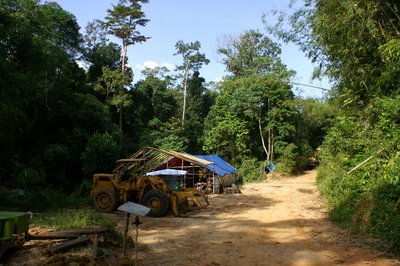
This was 'home for us for a night - very pleasant too!
After checking the local Bat Hawks (one was on show), we started birding around the camp. Almost immediately we came across a 'bird wave' - a mixed flock of several species moving through the trees. Among them were many Eastern Crowned Warblers, Bar and Black-winged Flycatcher-shrikes, and a number of Ashy Minivets. Ashy Minivets are quite common winter visitors here. However, while watching the Ashys, we came across another minivet with them that was similar in most respects, but pale yellow where the Ashys were white. The only species we could assign it to was Rosy Minivet, a species that occurs commonly in parts of Thailand in the northern winter, but has not been recorded previously in Malaysia.

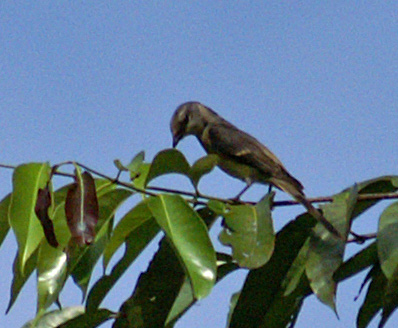
Two distant shots of the possible Rosy Minivet. These shots are a bit dark. The bird showed pale yellow underparts, forehead, rump and wingbar on the greater coverts.
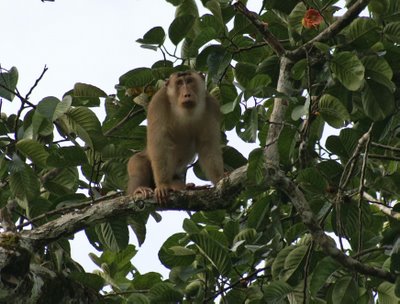
A male Pig-tailed Macaque glares at us from the top of a fruiting tree.
A couple of Wreathed Hornbills flew over the canopy distantly, and then we moved deeper into the forest to where Choo Eng had seen the Tapirs previously. The footprints of both Asian Tapir and Asian Elephant were much in evidence, as well as the dung and pungent odour of the latter. We came across a number of elephant trails moving through the forest to converge on an area of river bank where the animals obviously gather to drink and bathe. There was also an extensive muddy 'wallow' which was much used to judge by the number of footprints. By the river, groups of colourful butterflies hovered around pools of elephant urine.

An elephant trail.
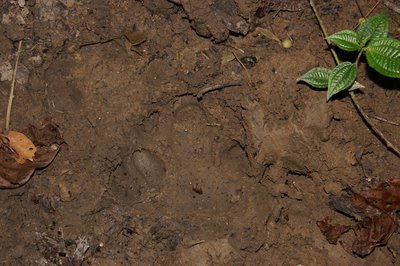
The distinctive three-toed footprint of an Asian Tapir.

Elephant Beach! Note the dung and pools of urine in the foreground. At least they don't leave plastic bags all over the place!
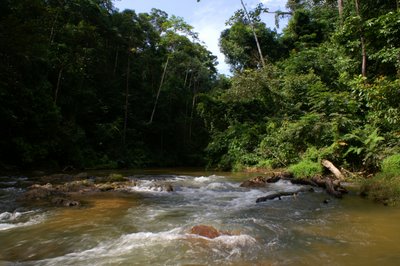
Looking upstream from the previous photo.
We found that there was a surprising number of human visitors to the forest as well. We met a couple of orang asli hunters, equipped with a blowpipe, who showed us a large freshwater turtle that was headed for the pot. We also met and chatted to a group of local bird-trappers, who spent many minutes poring through Choo Eng's field guide, unerringly pointing out and identifying a large number of species they were familiar with. We learned a number of local names from them - Burung Merlau (Blue-winged Pitta), Burung dek-dek (an onomatopeic name for flowerpeckers), and Burung Barau (Straw-headed Bulbul). Their main interest, however, was in Leafbirds (Burung Daun). They accurately identified the three species that are present in this area of forest.
At dusk we spent some time waiting for the Bat Hawks to return to their tree, which they eventually did. Then it was time for a swim in the cool, clear river - heaven on earth after a hot day in the forest!
After a sumptuous meal of sausages, chicken and noodles, we set out for a night foray into the forest once more. We heard the sounds of large animals moving through the undergrowth, but saw very little in the way of wildlife.
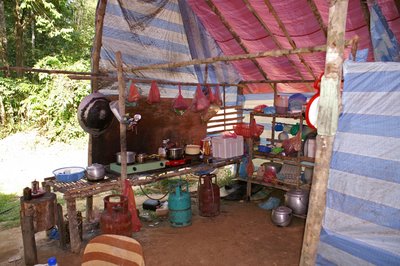
Our kitchen.
By the end of the day we had recorded the following species:
Asian Paradise Flycatcher
Bat Hawk
Eastern Crowned Warbler
Bar-winged Flycatcher-shrike
Black-winged Flycatcher-shrike
Asian Brown Flycatcher
Verditer Flycatcher
Wreathed Hornbill
Spectacled Bulbul
Striped Tit-Babbler
Ruby-cheeked Sunbird
Dark-throated Oriole
Blue-crowned Hanging-Parrot
White-bellied Yuhina
Grey Wagtail
Ashy Minivet
Rosy Minivet?
Great Argus
Crested Goshawk
Brown Fulvetta
Whiskered Treeswift
Dark-sided Flycatcher
Sooty-capped Babbler
Crimson-breasted Flowerpecker
Raffles' Malkoha
Chestnut-breasted Malkoha
Asian Fairy Bluebird
White-rumped Munia
Pacific Swift
Silver-rumped Needletail
Buffy Fish-Owl
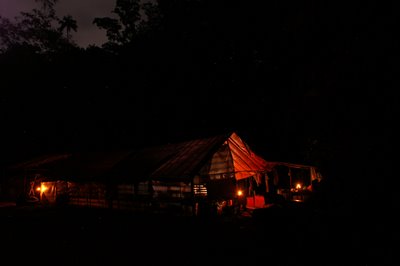
The camp by night.
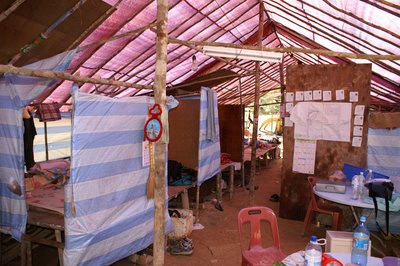
Our sleeping arrangements were basic but good enough for a decent night's sleep.
Early in the morning on Jan 2nd Choo Eng managed to photograph the Bat Hawks mating. Later, near the mud wallow, we photographed a co-operative female Banded Kingfisher, which came to us as we imitated its call. We watched it hunt and catch cicadas for about 15 minutes. During this time we heard several footfalls of elephants in the nearby forest.
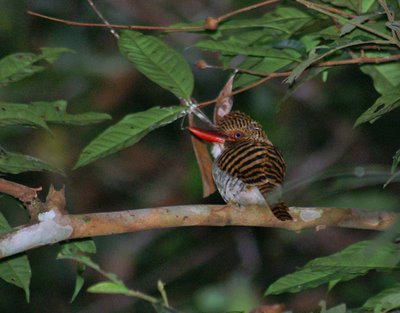
We noticed that the bird continually raised and lowered its crown feathers, making it look as if it were permanently raising its eyebrows in surprise!
Birds we added to our list today were:
Banded Kingfisher
Red-billed Malkoha
Scarlet Minivet
Rhinoceros Hornbill
Red-bearded Bee-eater
Black-thighed Falconet
Yellow-bellied Warbler
Lesser/Greater Green Leafbird
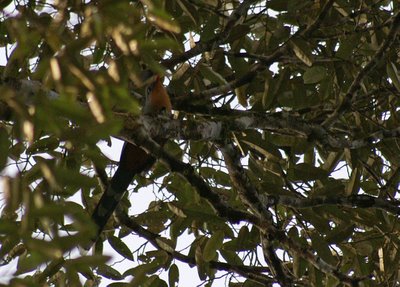
A Red-billed Malkoha, located by its curious frog-like croak.
After a final bathe in the river we reluctantly headed back to 'civilization' after an idyllic couple of days close to nature.

A day-flying moth (I think) with a body resembling a hornet drinking at the river.
A quick check at a site en route home yielded a single Small Buttonquail - another species that was only recently recorded in Malaysia for the first time.
2 comments:
A very productive trip - even if you had to 'rough it' a little!!
Hi Matthew,
Yes, and it didn't seem too rough! Actually, bathing in the river in the rainforest was a luxury money can't buy!
Post a Comment